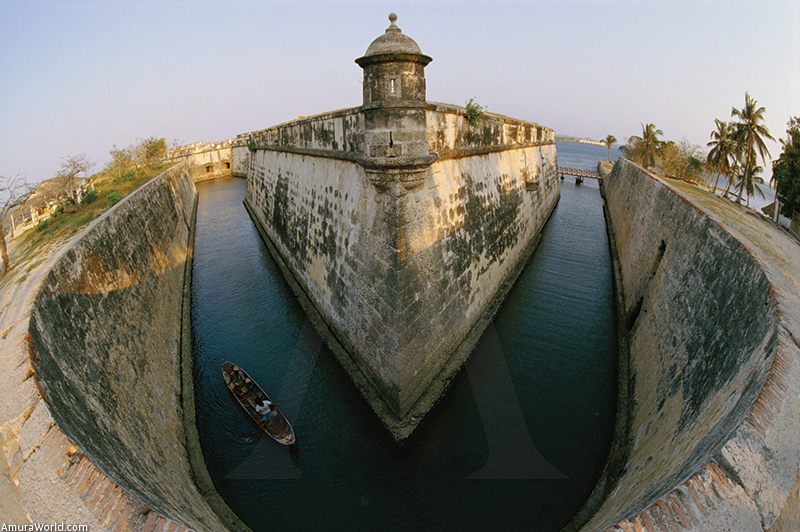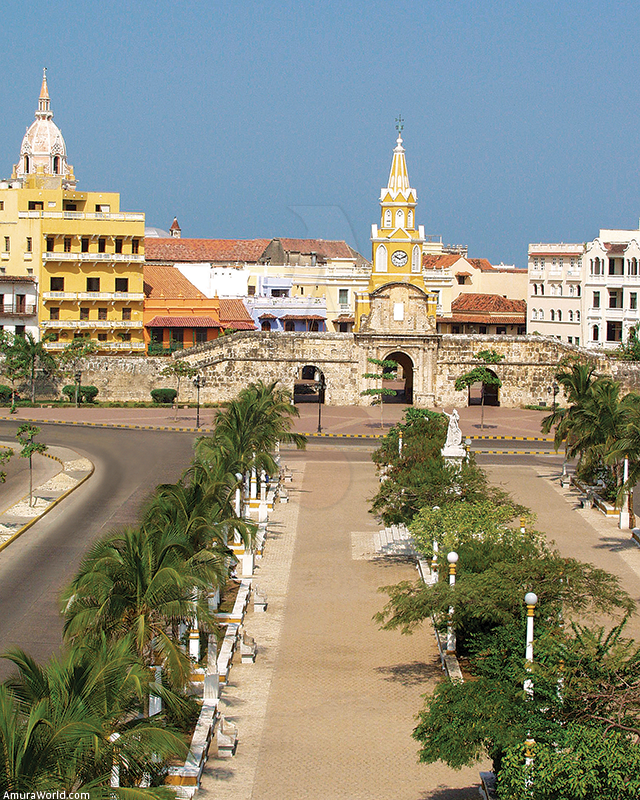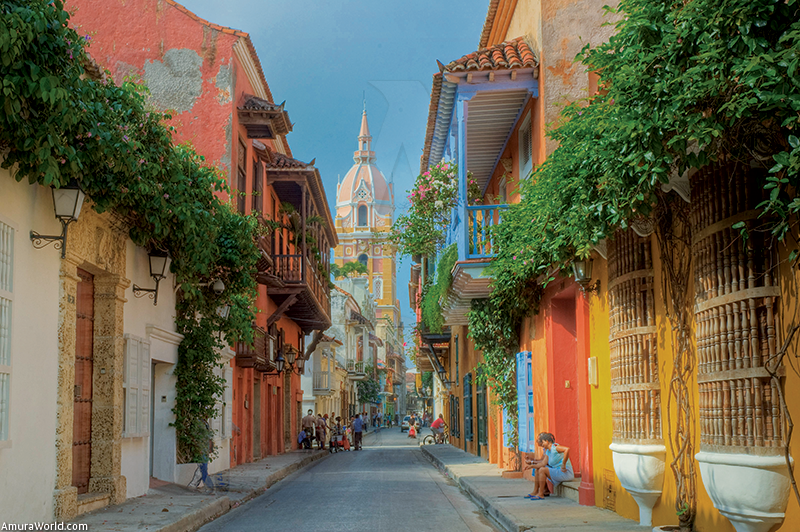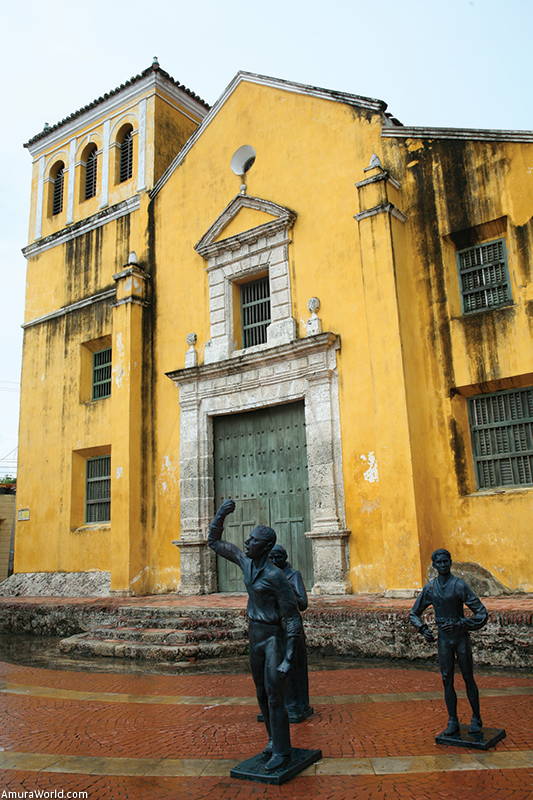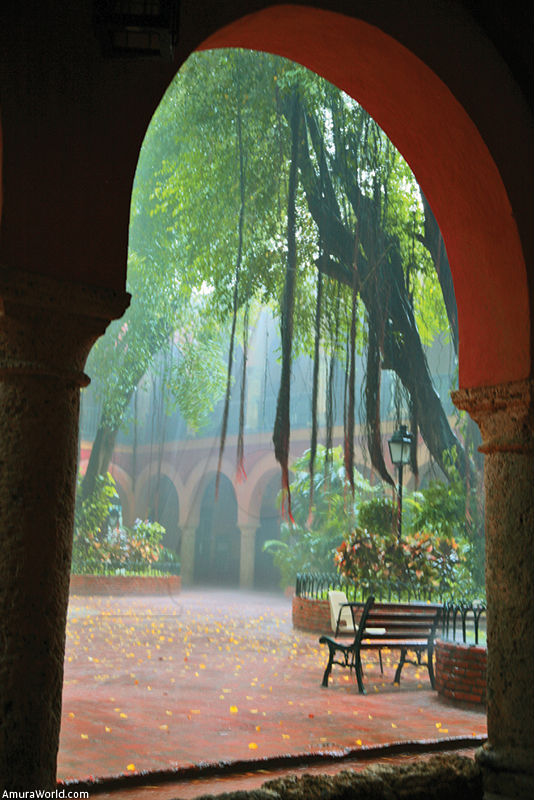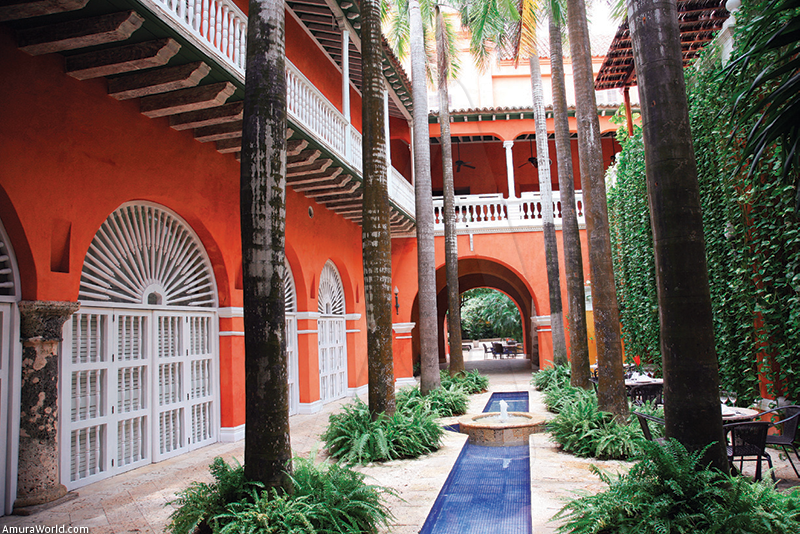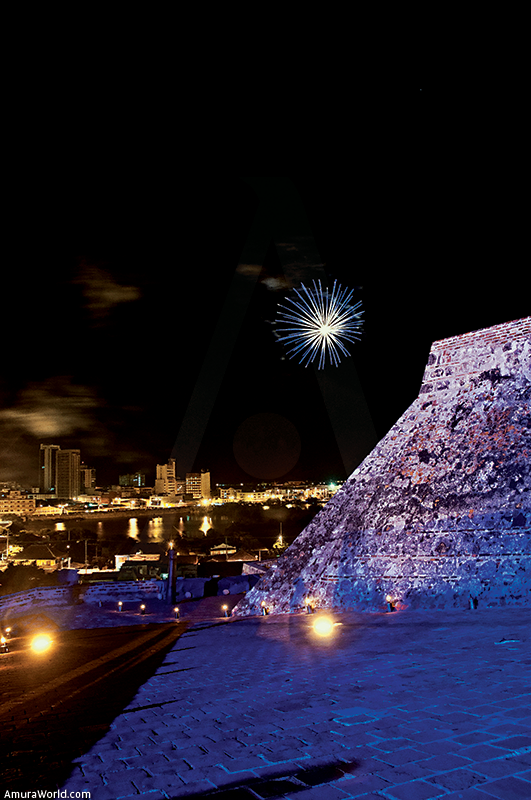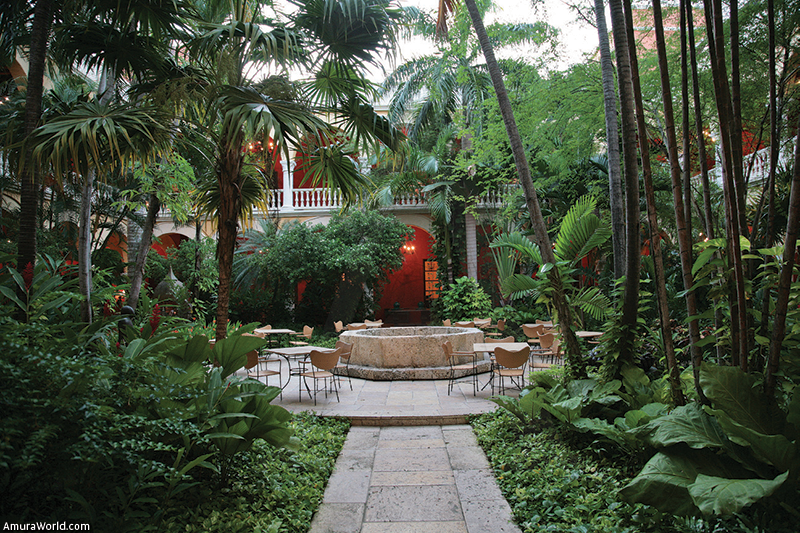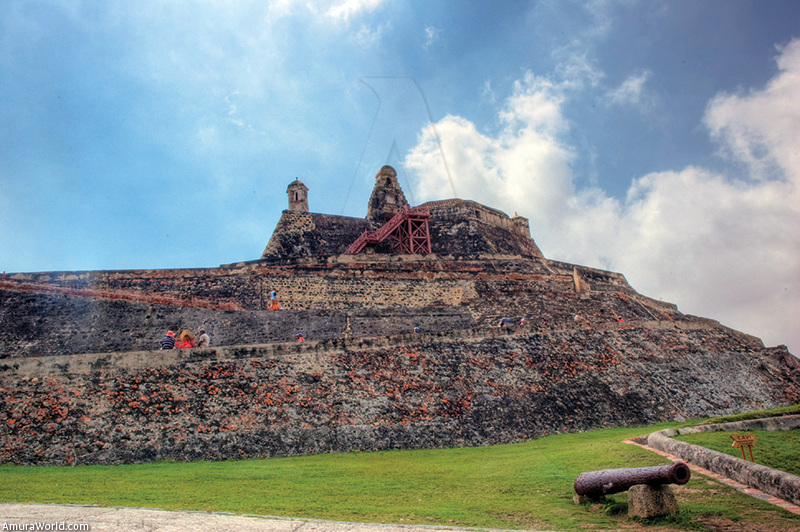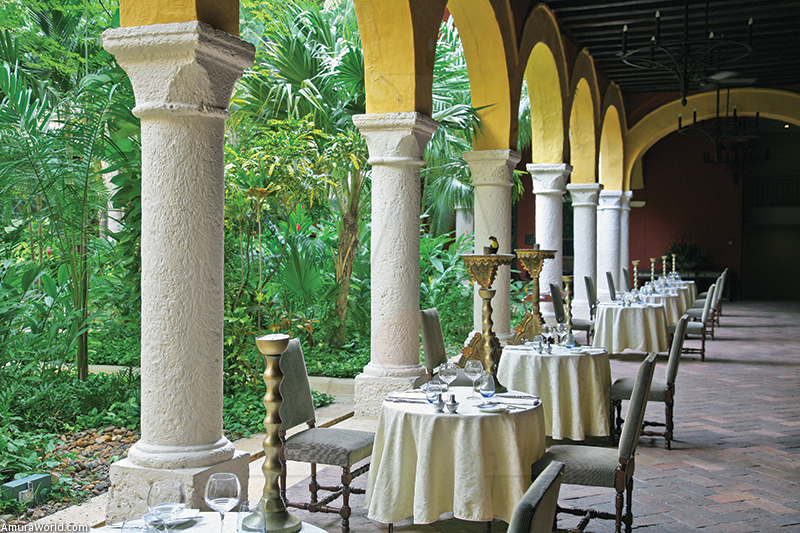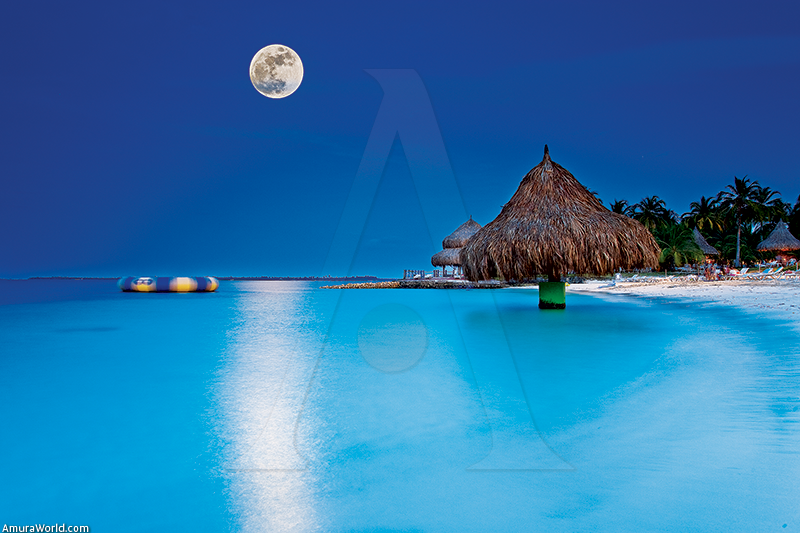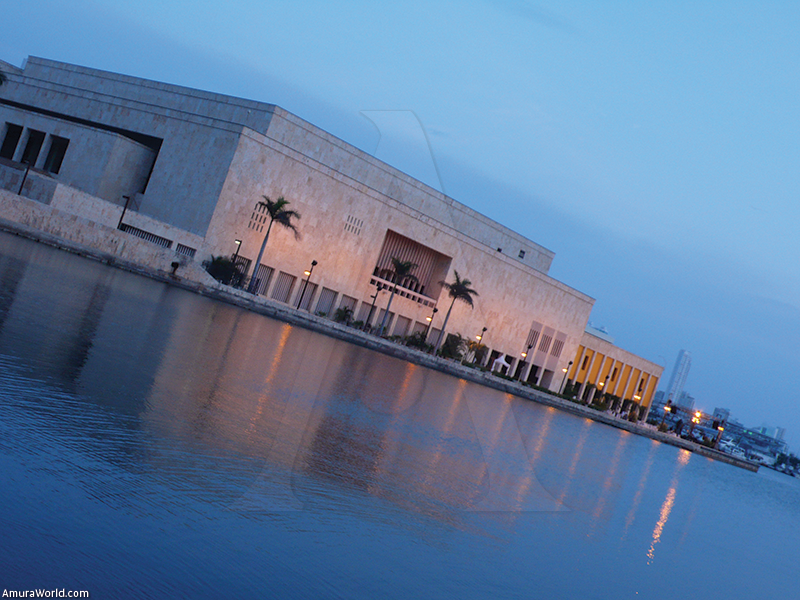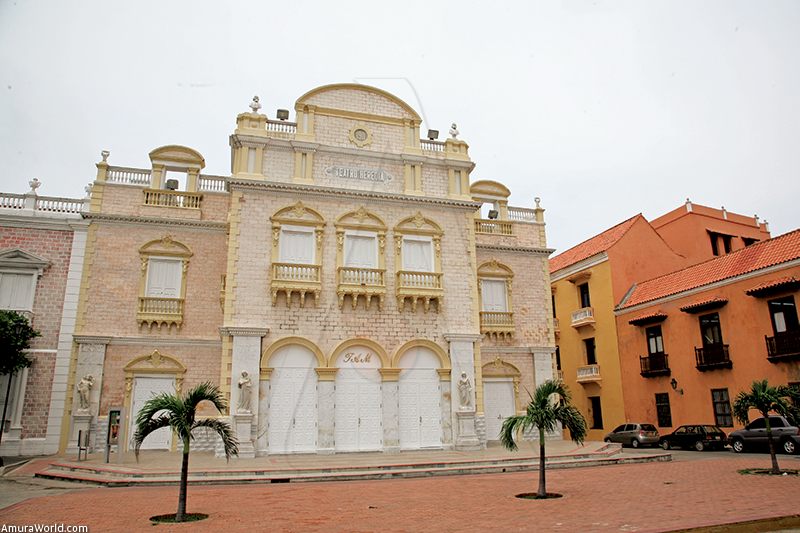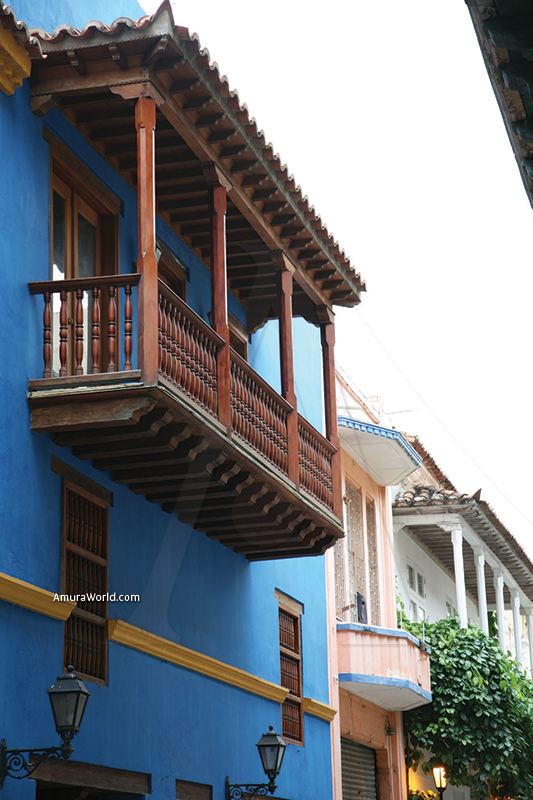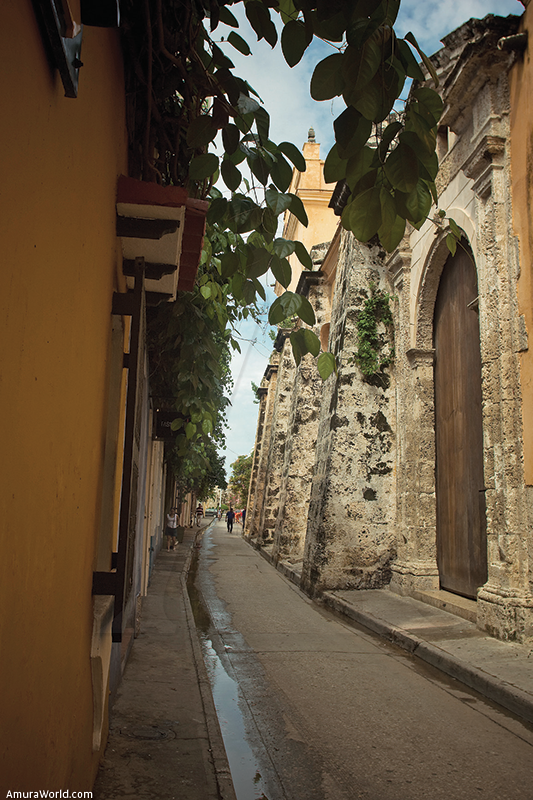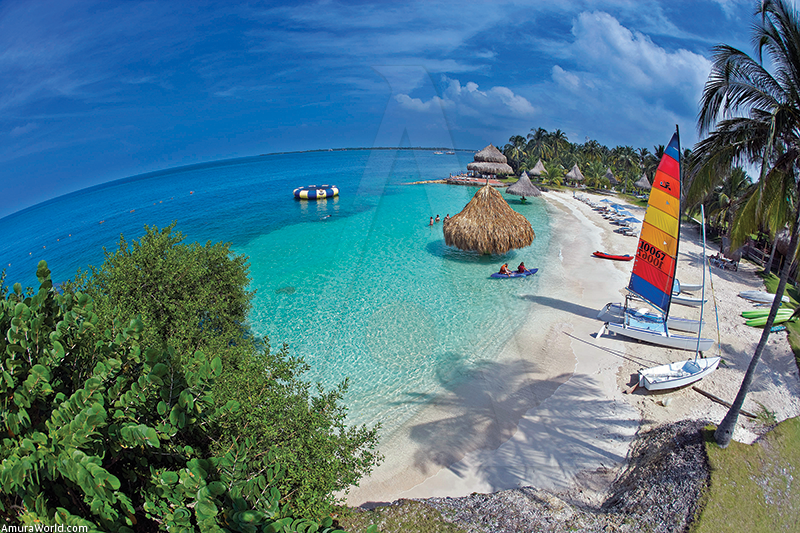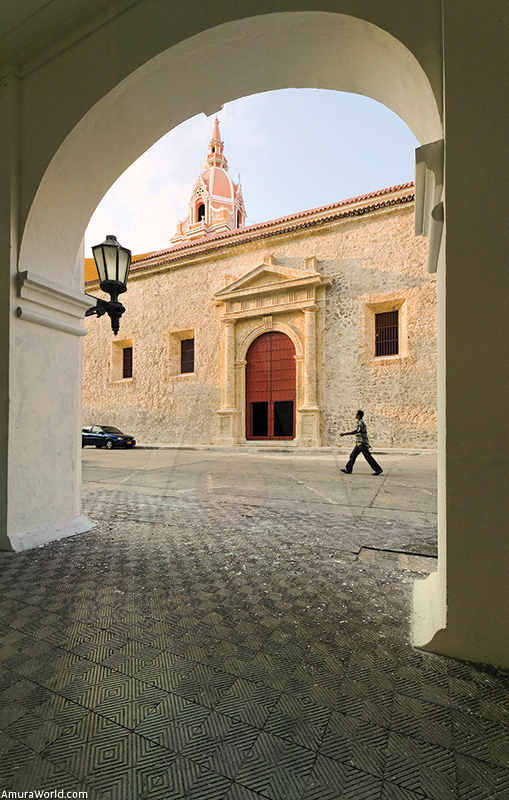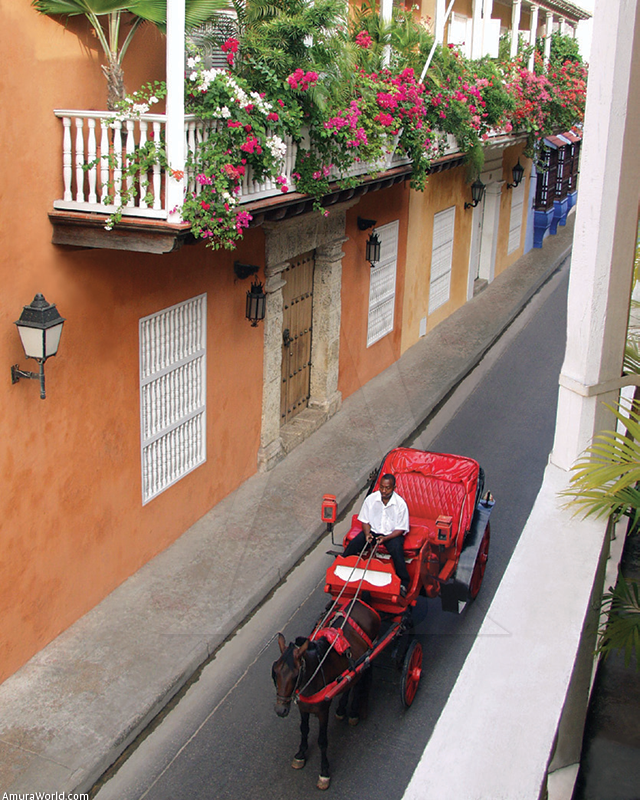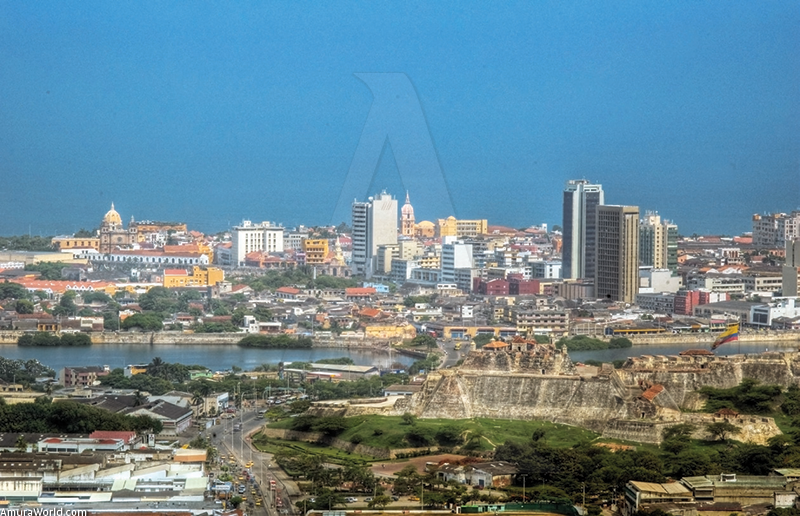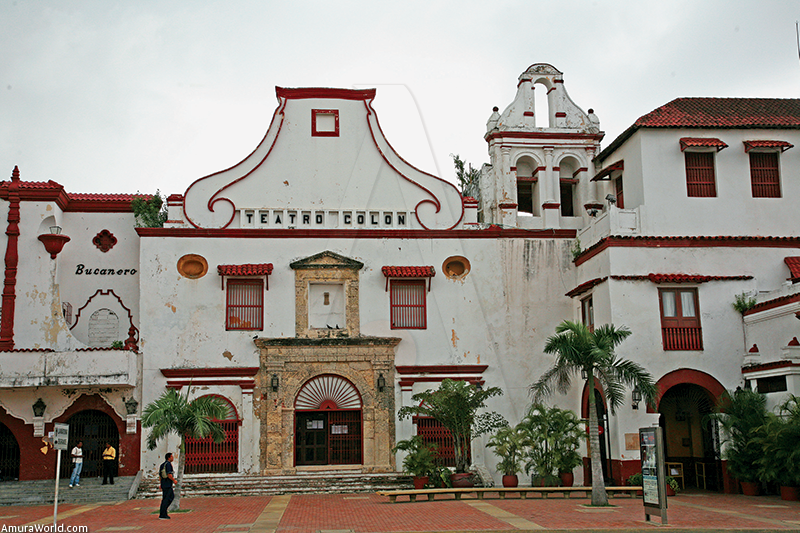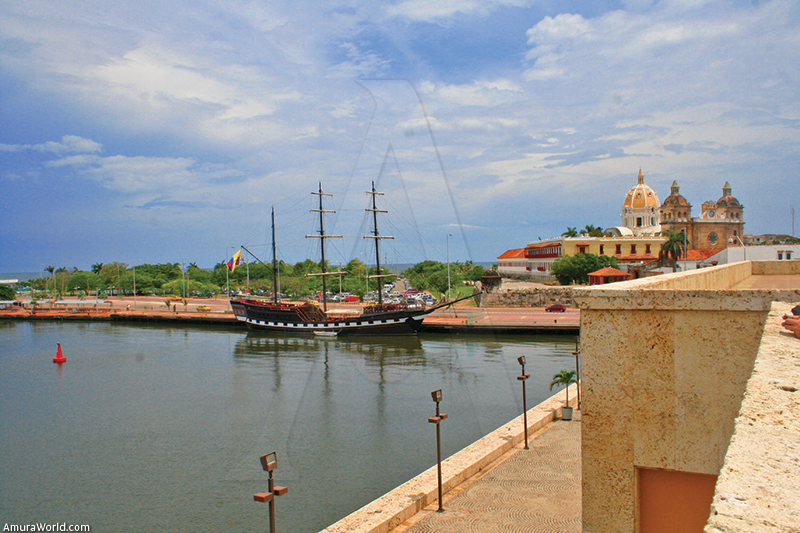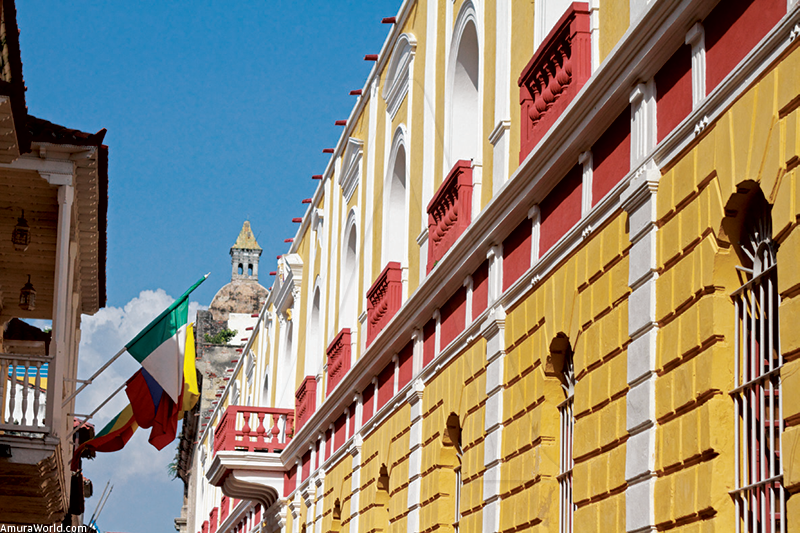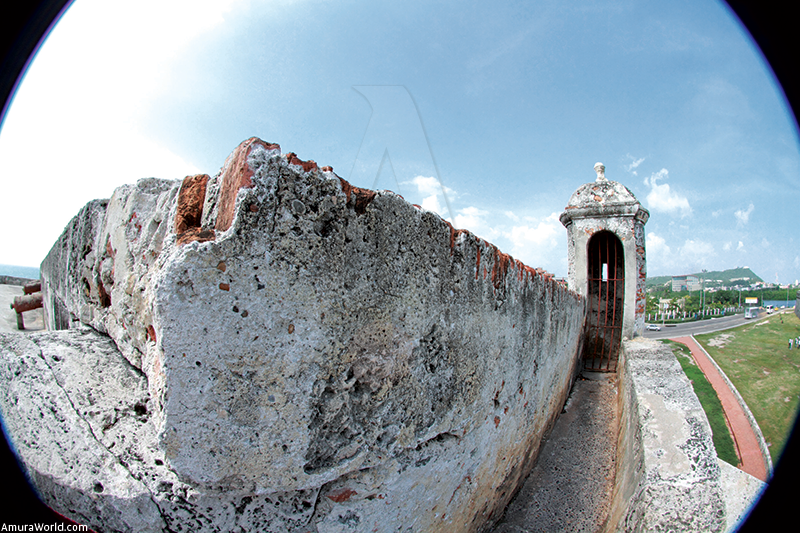On the shores of the Caribbean sea, Cartagena de Indias is an invitation for one to experience an exquisite adventure through time, where the colonial and the folkloric traditions merge with the XXI century, and convoke travelers to meet this marvel, the main tourist destination in Colombia. The wall built over four centuries ago appears to conserve the sounds of bygone battles, and the frantic arrivals and departures of merchant ships, as if history had been set, literally, in stone. The skyscrapers defy the ocean breeze, and guard the historic center (known as the “Walled City”) while the port, foremost in the country, continues to be a highly sought after attraction for international commerce, as well as for the cruise ship industry.
Cartagena was a treasure in and of itself which pirates longed for, a compass in uncertain days; one that continues to be a precious destination with unfolds to the rhythm of the champeta, the mapalé, the cumbia and the son, and where the color of the skin tell the story of its relationship with Europe, the African continent, and numerous sites in America.
City of magic and legend
When the aircrafts doors were opened a heat cloud enveloped us, welcoming us in this manner and announcing that we had arrived to a vibrant location, where living means submitting oneself to the vital pulse of the city. Cartagena de Indias, capital of the Department of Bolívar, is a fascinating territory full of history which ignites the imagination.
Cartagena de Indias is also a faithful witness to the most significant events of its colonial history; of the events that led to its Independence, and of the republican life lived up to the present time. Its name was, is, and will continue to be linked with legend and history, in the same manner that it is united with the folklore, culture and the politics of Colombia, and Latin America as a whole.
The History
Cartagena de Indias belonged to the calamaríes when the first Spaniard, Rodrigo de Bastidas, arrived in 1503; founded in 1533 by Pedro de Heredia, when he erected a fort on Calamarí Island, and began to trace the outlines of the city, creating a fortress to protect the Spaniards that would subsequently arrive. The port began to garner importance in large part to the protection that this strategically built fortress provided for Spanish militias, via the erection of walls and adjacent forts. Since colonial times, it was one of the most important ports in America, and symbol of Imperial Spaniard rule in the New World.
The city was sacked numerous times by pirates and foreign troops; for this reason, King Phillip II ordered the construction of eleven kilometers of walls and fortresses to protect the city. Proving to be so effective as to halt the famous siege that the English Admiral Edward Vernon wished to threw with the aid of eighty-seven vessels, and thirty thousand men. In spite of the size of this important fleet, the English were defeated, and retreated after failing to capture the city.
Cartagena declared its independence from Spain on November 11th, 1811, and kept moving forward in spite of the siege carried out for three months in 1815 by the Spaniard Pablo Morrilo, who incarcerating the insurgent army inside the city until his army collapsed and the insurgency emerged victorious. As it is the case in the Caribbean, a large number of black slaves were brought to work on the lands, even after the country had gained its independence. Cartagena as a city was making great progress, product of hard work and pride. Life was peaceful in this age, moving to the rhythm of the tropical climate, and the vibrancy of its ports. Merchant commerce intensified the life of Cartagena; with various commodities following their course through the Magdalena river, the only viable system of transportation inside the country. With the passing of time, Cartagena transcended the sphere of shipping ports, and is today an important cultural, industrial and tourist center.
Night Walk
Evening was closing in on the city, the sky charged with threatening clouds, dragging the humidity down to the narrow streets. I left the Sofitel Santa Clara with the idea in mind to discover the ambience of the historic part of Cartagena, where the heritage of Spanish architecture is reflected. I submerged myself in one of the most beautiful cities in the world, discovering its plazas, its adorned streets lined with houses upholstered with balconies and tall, barred windows. I climbed the wall to admire the sunset from a stone pedestal. The people frolicked in the streets below to feel the fresh breeze, while the city steets lights began to twinkle, gradually illuminating the entire city.
The champeta, local music of Cartagena, and tracing its origins European-African songs, was heard in all corners. From other locations one could hear the cumbia, and in the Plaza de Bolívar a elegant group of men and women danced. A large number of these people where of African origin, carrying themselves in a manner that fully characterizes them, beaming as they danced. Others were Caucasian, as if brought directly from Spain, while many others were mestizos, a mixture of both races, all carrying in their blood the traditional history of Cartagena. Through the alleyways from whence one arrives to the plaza, I admired beautiful casonas with open doors, rich in history, and saw the restaurants’ terraces filled with diners.
I felt intoxicated by the ambience, joyful for the music and impressed by the beauty of the architecture of each of its buildings. I returned to the Sofitel Santa Clara, astounded by the experience of that brief adventure through the walled city, abundant in architecture; one brimming with vitality and full of flavor, sounds, and colors.
Discovering the city
After a delicious breakfast at the Sofitel, while enjoying the jungle vegetation inside its gardens, we departed towards the San Diego Plaza, where the trees provided refreshing shelter, and the restaurants’ terraces call for one to experience the fine Colombian cuisine.
The ex-Convent of San Diego rises from the corners of the Plaza, where the neo-gothic church is found, home to an elegant patio. Constructed in 1608, today it harbors the Superior School of Fine Arts, which gives the San Diego Plaza a youthful air. Striding through Torno street, I arrived at the wall, observing the Hotel Boutique Bóvedas of Santa Clara, which conserves its beautiful façade, its interior predominated by a minimalistic style. Adjacent to the bulwark of Santa Clara, and the bastion of Santa Catalina, an imposing fort that merges with the wall, are found the vaults that harbor forty-seven arches and twenty-three vaults. Built in 1792, they served as storage rooms, as well as prison cells. Currently, they are shops where travelers can find attractive local crafts.
Following our course, and passing by the imposing Colegio Salesiano San Pedro Claver, we made our way into the heart of the ancient city full of surprising locations and beautiful houses with balconies adorned with flowers. We visited the church of Santo Toribio de Mangrovejo, with its simple white and yellow façade, in front of the Fernández de Madrid park, admiring the varied architecture of the area.
We arrived at the Convent of San Agustín (XVI century), which today is home to the University of Cartagena. The Church of San Agustín tower flaunts an Italian style, revealing pain-staking details in its arched windows. The streets were flocked with locals and travelers, beautiful women in colorful dresses, fruit vendors and numerous shops. Close to the imposing convent one finds the colonial style home of none other than Simón Bolívar.
Afterwards, we arrived to the more vibrant, more commercial central plaza, leaving behind the tranquil roads, walking under the shadows offered by the balconies. I reached, then, the cathedral, a majestic place of unequalled beauty. Its construction began in 1575, and in 186, when one tower was due for completion; the pirate Francis Drake partially destroyed it. In the year 1612 the building was finalized, a Florentine-style copula added to the Cathedral. Its imposing stone wall housing an austere wood and marble interior, in which people prayed.
The Bolívar park, at the heart of the historic center, is home to numerous trees and fountains that cool the air. The people rest on benches, while musicians enliven the ambience of the place. During the nights, popular dancing spectacles typical of the region can be enjoyed. In the midst of this tropical vegetation one finds the equestrian statue of Simón Bolívar, as eternal vigilant of Cartagena. Here I discovered the Palace of the Inquisition, of Barroque style, features splendid wooden balconies, and which is the now home to the Museum of History. On the other side of the park shines the Museum of Gold, harbored inside a beautiful colonial house, and which guards fascinating pre-Hispanic pieces of wondrous design pertaining to the sinú culture, recognized in the region for their hydraulic works to control flooding in the area.
Following our course through various streets, we discovered beautiful colonial couses, such as the Skanda house, the Cano Galeria, the Bodgeón de la Candelaria, The Naval Museum and Library, located next to the Baluarte de San Francisco, the Arms Plaza, until we arrived to the San Pedro Claver Plaza, dominated by an imposing church of the same name. The church and the monastery where built by Jesuits in the XVII century, the façade is made of coralline stone while the cloister features a large quantity of vegetation. For its part, the museum exposes fabulous works of art. San Pedro Claver was the defendant of the rights of slaves, and his remains are conserved inside the church.
From the Museum of Modern Art emerges a small road that leads one to the Aduana Plaza, through the impressive Aduana building, and the pompous Royal Award Marquez House. This colonial style house, from the XVIII century, owes its beauty to its balconies and tall windows fitted with wood frames. In this same plaza one finds the home of the late Pedro de Heredia, founder of Cartagena. The Aduana building, erected in 1622, featuring elegant arches through which merchandise was received, while the first floor, home to the Treasury, accounting and living quarters of its employees, is now occupied by the Mayor and his staff. The center of the plaza is dominated by a statue of Christopher Columbus.
Through the Bulwark of Saint John the Baptist, between the Plaza de los Coches, where the statue of Heredia rests, adjacent to the Portal de los Dulces, brightly colored houses are sustained, which houses candy vendors, typical of the region. In front of this one finds the crumbling wall which served as the principal gateway to city, originally conceived as a single arch. It has been transformed with the passing of time, workers adding two further arches, and a Tuscan-style tower in 1888. Once outside, we found ourselves the edge of the Bay of Animas, surrounded by the modern conventions center, and the Dock of Pegasus, home of elegant statues.
Afterwards, we arrived at the popular neighborhood of Getsemaní. There we encountered the Convent of San Francisco, imposing building built between 1555 and 1560. During our stay at the cloister, which now serves as a school, I was surprised by a torrential storm, and I was thankful for the shelter inside the building. Once outside, I walked until I crossed Broad Street, to visit the restaurant La Cocina de Socorro, were I enjoyed an excellent meal of criolla, seafood, and delightful fish. I concluded my visit to the Getsemaní neighborhood by travelling through the Trinity and San Roque church, as well as the Centennial Park, bordered by elegant buildings.
Upon my return, I discovered other buildings that beautify Cartagena: The Convent of Santo Domingo (built in 1550, featuring a lavish cloister that harbors the Centro de Formación de España, and the church where one finds the magnificent image of the Virgin Mary, a gold crown resting on its head, and adorned with emeralds), the Plaza of Santo Domingo, the House of the Marques of Valdehoyos (typical aristocratic house of the XVII century, featuring salons, patios and splendid gardens). Following the Calle de la Factoría, I arrived at the wall and the Plaza de la Merced, home of the elegant Heredia Theater, built in 1911, which exhibits stairwells and marble sculptures.
My day was concluded in the Sofitel Santa Clara, after enjoying an exquisite French dishes that the restaurant El Refectorio offers, although the night was inviting me to walk through the streets of this magical city, listen to the music that animates the plaza, enjoy the bars and become acquainted with the kindness of the people.
Rosario Islands
In the morning, we boarded a fast boast at the Manga Port, a neighborhood where lavish mansions surge between the vegetation and the Fountain of San Sebastian of Pastelillo. On the other side of the Cartagena Bay, the talk buildings of Boca Grande and Castillo Grande can be admired – an exclusive residential area. We traveled through Tierrabomba island, where the Fort of San Fernando and the Forst of San Jose in Boca Chica, built in the XVII century, display the typical architecture Spaniard colonial architecture. These forts protected the entrance of the maritime bay, between the Tierrabomba island, and the Barú Peninsula. Boca Chica is a small fishing town, which offers peaceful beaches and local cuisine, while one enjoys the an amicable landscape dotted by men navigating in small fishing boats.
After forty-five minutes of navigation, we arrived at the National Archipelago Park of Our Lady of the Rosary, situated at forty-six kilometers to the southeast of Cartagena, and composed of twenty-six islands, surrounded by coral reefs. Here, the water is crystal clear, the vegetation is exuberant, and there exist internal lagoons and a tropical ambience ideal for relaxation. We landed on the largest of these islands, and lodged at the Majagua Hotel, which combines nature and luxury inside an intimate environment in the midst of the jungle.
Once we were properly settled at the Majagua, I went diving, wanting to observer the fabulous coral reefs and colorful fishes. In search of adventure, we undertook an unfamiliar journey through the jungle, walking under the trees until we reached the fishing town. Boarding kayaks, we navigated through the lagoons that meet with the sea. In one of these lagoons we observed eerie medusas that rest at the sandy bottom of the lagoons. In another, we had to return, at night, to observe a rarity in its waters, a phosphorescent phenomenon. It was a day of unforgettable adventures; under the stars, we relived this experience, while we enjoyed the marvelous Caribbean waters. Next morning, we returned to Sofitel Santa Clara and, as we were about to reach the skyscrapers of Boca Grande, a torrential caught up with us the minute we disembarked at the dock.
Romantic flavors and military architecture
On the final day of our stay in Cartagena de Indias, we decided to walk once more through its precious streets, and the architecture evokes romantic scenes. We discovered the best restaurants: La Vitrola, El Santísimo, El Claustro de Santa Clara, Juan de Mar, San Pedro, amongst others.
To continue our adventurein order to further know the richness of the city, and as part of the “Fourth Wonder” of Colombia, we traveled to the Castle of San Felipe of Barajas, once the largest military complex in America, located on top of a hill overlooking the city. Its imposing fortified architecture dominates this strategic point, in its time serving as a spot to keep an eye on invaders, by land or sea. Its construction lasted more than a century, commencing in 1536 and culminating in 1657. It triangular form possesses four control posts, and eight canon stations. It resisted various assaults, as it occurred in 1741, when English troops under the command of Admiral Vernon attacked. It was taken only once, by the French Commander De Pointis. In 1762, even taller walls were erected, making penetration impossible, as well as the addition of sixty-three canons, making for a formidable defense. In conclusion: an impenetrable fortress. From the top of this outpost, the view is dominated by bay, the ancient city, and, on the other side of the bay, the tall buildings of Boca Chica. There we explored the tunnels and galleries, and finally de Convento de la Popa, which dominates the hill.
Fantástica desde el aire
Once in the comfort provided by Lan, after liftoff, I was able to observe the unusual design of this immense bay that is home to one of the jewels of the Caribbean. Long, and placid streets that enamor, wooden balconies and beautiful gates that evokes a romantic air, the thundering of horses galloping besides tourists, the touch of the warm breeze, the music in the streets, and the joy of the people. Cartagena de Indias is a treasure to admire, to know and to travel through its geography and history.
The passing of time makes Cartagena de Indias even prettier: it conserves it historic center, declared National Patrimony of Colombia (1959) and Patrimony of Humanity by UNESCO (1984); it continuously refines its port, one of the most importants in the country; it is a famous and unparalleled tourist destination that every day offers more and better beauties as a consequences of its interrupted development. The fabulous historical richness of Cartagena de Indias does not cease to grow, century after century. It is, in short, a call towards the extraordinary.
Text: Patrick Monney ± Photo: Patrick Monney, PROEXPORT Colombia, Getty Images

